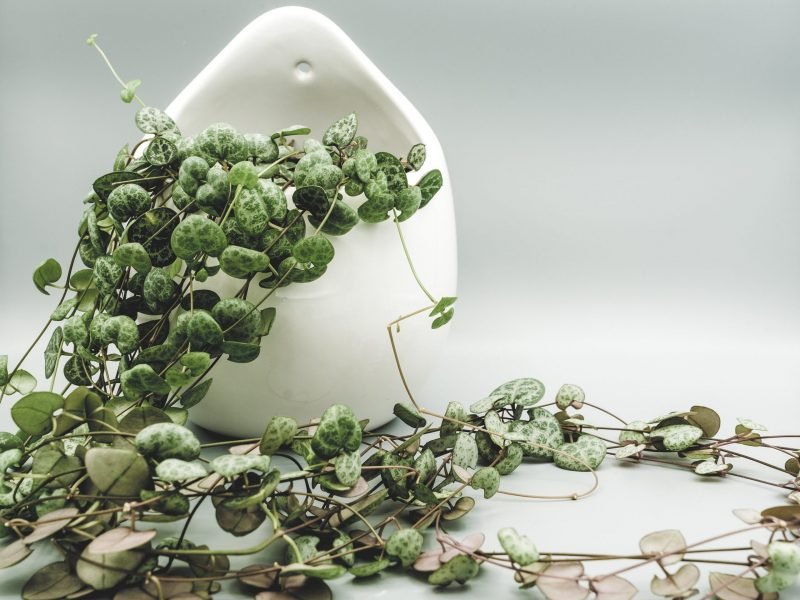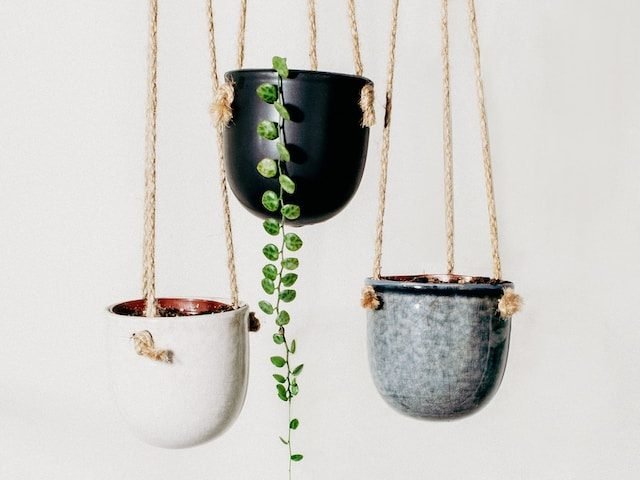
Basic String of Hearts Care
One of the most popular plants out there, the String of Hearts is a fairly low-maintenance and fast-growing plant. However, the best thing about it is actually the ease with which you can propagate it. Pop a few vine cuttings in water and they will root within days.
There are a few things to note when caring for your String of Hearts and that is that they don’t like low-light areas but also dry out if hit with too much direct sunlight. So a balance is key here. The second thing to know is that they hate their potting mix being soggy so make sure to use a well-draining mix and water only when the soil is dry.
Below you will find our full String of Hearts care guide with all the information you need for your plant to thrive.
Detailed String of Hearts Care
String of Hearts love sunlight
Your String of Hearts loves bright areas of your home. They can deal with a few hours of direct sunlight each day but prefer to be in a spot with indirect light so their leaves don’t burn. Your String of Hearts may struggle a little in the darker winter months (this can result in leggy growth) so you might want to move them a little closer to the window during winter.
They don’t like sitting in water
The String of Hearts is a type of succulent meaning that they don’t do so well in damp soil. When caring for a String of Hearts plant is very important that you let them dry out between waterings otherwise this will very quickly lead to root rot.
String of Hearts prefer average humidity
String of Hearts plants thrive best in 40-50% humidity which is what most households should be naturally. This means you don’t need to worry about misting or increasing humidity levels for your String of Hearts which makes them a pretty easy plant to take care of. Read our houseplants guide to humidity if you want to find out more.
String of Hearts plants prefer warmer temperatures
When caring for a String of Hearts plant, we recommend keeping it in a slightly warmer area of your home. They don’t do so well in cooler temperatures so make sure your plant isn’t sat next to drafty windows or doors.
String of Hearts plants are easy to propagate
The String of Hearts may just be one of the easiest plants to propagate. Cut off a piece of the vine just above the node (where two heart leaves are) and place in water or soil. Roots should grow within a few weeks! We have written a whole guide on how to propagate your String of Hearts if you want to know more.
String of Hearts don’t need regular fertilisation
To encourage new growth on your String of Hearts, you may want to give it some fertiliser. However, make sure you only feed it once a month during the growth periods of Spring and Summer, and not at all during winter. We also recommend fertilising your String of Hearts at half-strength.
Only ever repot during the growth period
String of Hearts plants don’t need constant repotting as their roots are delicate and won’t become root bound very often. If you do want to repot your String of Hearts, try to only do it during the growth months of Spring and Summer as this will minimise shock.
Don’t worry about pruning your String of Hearts
String of Hearts plants don’t need to be pruned like other houseplants. As long as you cut off the odd dead stem, and propagate cuttings if it gets too long for your space, there isn’t really any need for pruning your String of Hearts. Just another reason why String of Hearts are so easy to care for! If your String of Hearts has a few leggy vines, then you may also choose to prune these for aesthetic reasons.
String of Hearts plants are safe for pets
Another reason why we love the String of Hearts plant is because they are non-toxic to pets and humans. This means you don’t need to worry about putting it out of reach of your furry friends or children.
String of Hearts Care FAQs
Is the String of Hearts toxic?
String of Hearts are non-toxic to pets and humans which is a relief as they can often hang in reach of pets and children.
How fast does the String of Hearts grow?
String of Hearts plants are quite fast growers and in the growth period of spring and summer, you should see new leaves growing at the end of the vines all the time.
How much sun does the String of Hearts need?
Your String of Hearts loves bright areas of your home. They can deal with a few hours of direct sunlight each day but prefer to be in a spot with indirect light so their leaves don’t burn.
How often should I water my String of Hearts?
The String of Hearts is a type of succulent meaning that they don’t do so well in damp soil. At most, you want to be watering your String of Hearts once a week during the height of summer and much less during the colder darker months. Monitor the soil moisture and adjust your watering schedule moving forward.
Common Issues for String of Hearts
Although the String of Hearts are relatively easy plants to care for, it’s still important to look out for any warning signs that might suggest it is struggling in its current conditions. The most common issues are yellowing leaves and dry, crispy stems.
Why is my String of Hearts leggy?
Large gaps between the leaves on your String of Hearts tends to suggest the plant isn’t getting enough light so try and move it to a sunnier spot to avoid new growth being leggy.
It can be quite common for String of Hearts plants to become leggy over winter and that’s not because of anything you did wrong but just because there is less sunlight in winter!
We often recommend trimming any leggy vines on your String of Hearts in spring and propagating the cuttings to create a fuller plant.
When winter comes around again, one way you can prevent leggy growth on your String of Hearts is to invest in a grow light to supplement the natural light.
Why are my String of Hearts’ leaves very light in colour?
If you notice the leaves on your String of Hearts plant are losing their colour it is often due to a lack of or too much sunlight. Try to move your String of Hearts to a different spot in order for it to regain more colour to its leaves.
Why are my String of Hearts’ leaves turning yellow?
Yellow leaves on a String of Hearts plant is usually due to one of two things; overwatering or cold temperatures. As this is quite a common issue, we have written a more detailed guide on yellowing leaves here.
Why are the leaves on my String of Hearts turning mushy?
If your String of Hearts is turning slightly mushy it is probably down to overwatering and consequent root rot. Check out our guide to root rot to help your String of Hearts recover.















